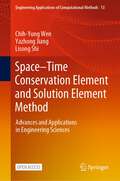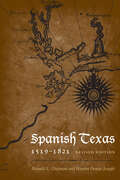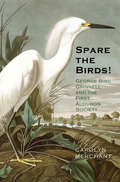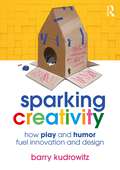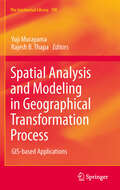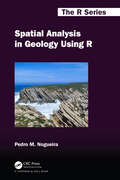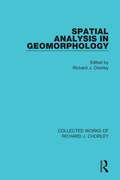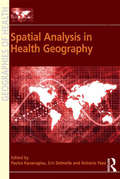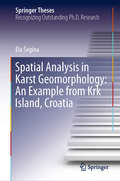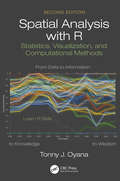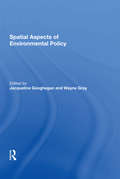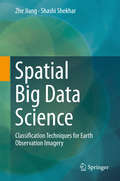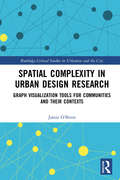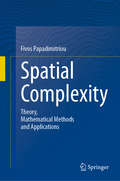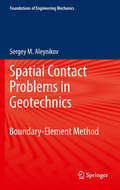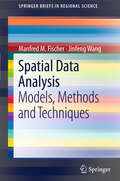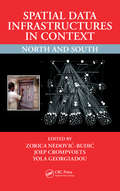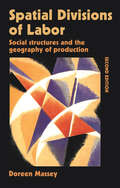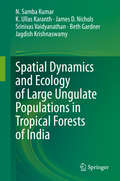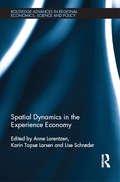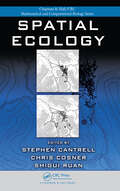- Table View
- List View
Space–Time Conservation Element and Solution Element Method: Advances and Applications in Engineering Sciences (Engineering Applications of Computational Methods #13)
by Chih-Yung Wen Yazhong Jiang Lisong ShiThis open access book introduces the fundamentals of the space–time conservation element and solution element (CESE) method, which is a novel numerical approach for solving equations of physical conservation laws. It highlights the recent progress to establish various improved CESE schemes and its engineering applications. With attractive accuracy, efficiency, and robustness, the CESE method is particularly suitable for solving time-dependent nonlinear hyperbolic systems involving dynamical evolutions of waves and discontinuities. Therefore, it has been applied to a wide spectrum of problems, e.g., aerodynamics, aeroacoustics, magnetohydrodynamics, multi-material flows, and detonations. This book contains algorithm analysis, numerical examples, as well as demonstration codes. This book is intended for graduate students and researchers who are interested in the fields such as computational fluid dynamics (CFD), mechanical engineering, and numerical computation.
Spanish Texas, 1519–1821: Revised Edition (Clifton and Shirley Caldwell Texas Heritage Series)
by Donald E. Chipman Harriet Denise JosephThis revised and expanded edition of the authoritative history of Spanish Texas features significant new discoveries throughout.Modern Texas, like Mexico, traces its beginning to sixteenth-century encounters between Europeans and Indians. Unlike Mexico, however, Texas eventually received the stamp of Anglo-American culture, so that Spanish contributions to present-day Texas tend to be obscured or even unknown. Spanish Texas, 1519–1821 undercores the significance of the Spanish period in Texas history. Beginning with an overview of the land and its inhabitants before the arrival of Europeans, it covers major people and events from early exploration to the end of the colonial era.This new edition of Spanish Texas has been extensively revised and expanded to include a wealth of new discoveries. The opening chapter on Texas Indians reveals their high degree of independence from European influence. Other chapters incorporate new information on La Salle's Garcitas Creek colony and French influences in Texas, the destruction of the San Sabá mission and the Spanish punitive expedition to the Red River in the late 1750s, and eighteenth-century Bourbon reforms in the Americas. Drawing on new and original research, the authors shed new light on the experience of women in Spanish Texas across ethnic, racial, and class distinctions, including new revelations about their legal rights on the Texas frontier.
Spanish Texas, 1519–1821: Revised Edition (Clifton and Shirley Caldwell Texas Heritage Series)
by Donald E. Chipman Harriet Denise JosephThis revised and expanded edition of the authoritative history of Spanish Texas features significant new discoveries throughout.Modern Texas, like Mexico, traces its beginning to sixteenth-century encounters between Europeans and Indians. Unlike Mexico, however, Texas eventually received the stamp of Anglo-American culture, so that Spanish contributions to present-day Texas tend to be obscured or even unknown. Spanish Texas, 1519–1821 undercores the significance of the Spanish period in Texas history. Beginning with an overview of the land and its inhabitants before the arrival of Europeans, it covers major people and events from early exploration to the end of the colonial era.This new edition of Spanish Texas has been extensively revised and expanded to include a wealth of new discoveries. The opening chapter on Texas Indians reveals their high degree of independence from European influence. Other chapters incorporate new information on La Salle's Garcitas Creek colony and French influences in Texas, the destruction of the San Sabá mission and the Spanish punitive expedition to the Red River in the late 1750s, and eighteenth-century Bourbon reforms in the Americas. Drawing on new and original research, the authors shed new light on the experience of women in Spanish Texas across ethnic, racial, and class distinctions, including new revelations about their legal rights on the Texas frontier.
Spare the Birds!: George Bird Grinnell and the First Audubon Society
by Carolyn MerchantAn engaging history of the founding of one of the world's most popular environmental organizations, the Audubon Society In 1887, a year after founding the Audubon Society, explorer and conservationist George Bird Grinnell launched Audubon Magazine. The magazine constituted one of the first efforts to preserve bird species decimated by the women's hat trade, hunting, and loss of habitat. Within two years, however, for practical reasons, Grinnell dissolved both the magazine and the society. Remarkably, Grinnell's mission was soon revived by women and men who believed in it, and the work continues today. In this, the only comprehensive history of the first Audubon Society (1886-1889), Carolyn Merchant presents the exceptional story of George Bird Grinnell and his writings and legacy. The book features Grinnell's biographies of ornithologists John James Audubon and Alexander Wilson and his editorials and descriptions of Audubon's bird paintings. This primary documentation combined with Carolyn Merchant's insightful analysis casts new light on Grinnell, the origins of the first Audubon Society, and the conservation of avifauna.
Sparking Creativity: How Play and Humor Fuel Innovation and Design
by Barry KudrowitzBlending popular culture and design theory, framed by a decade of scholarly research, this book highlights how play and humor fuel innovation. Now, more than ever, we are in need of creative solutions to global problems, but creative skills and abilities decline over time without intervention and practice. Sparking Creativity provides empirically supported methods for embracing the often-trivialized domains of play and humor to increase our creativity. It shows that topical examples, such as Seinfeld's humor, the Apples to Apples board game, and the Adventure Time cartoon series, are more closely related to innovation than you might first think. The book is organized into five main parts, each containing short, engaging subsections and informative, playful, and colorful illustrations to demonstrate concepts. Written in a humorous and accessible style, this book is aimed toward creative-minded entrepreneurs, designers, engineers, industry leaders, parents, educators, and students. It encourages a playful approach throughout a design process to produce truly innovative solutions.
Spatial Analysis and Modeling in Geographical Transformation Process
by Rajesh Bahadur Thapa Yuji MurayamaCurrently, spatial analysis is becoming more important than ever because enormous volumes of spatial data are available from different sources, such as GPS, Remote Sensing, and others. This book deals with spatial analysis and modelling. It provides a comprehensive discussion of spatial analysis, methods, and approaches related to human settlements and associated environment. Key contributions with empirical case studies from Iran, Philippines, Vietnam, Thailand, Nepal, and Japan that apply spatial analysis including autocorrelation, fuzzy, voronoi, cellular automata, analytic hierarchy process, artificial neural network, spatial metrics, spatial statistics, regression, and remote sensing mapping techniques are compiled comprehensively. The core value of this book is a wide variety of results with state of the art discussion including empirical case studies. It provides a milestone reference to students, researchers, planners, and other practitioners dealing the spatial problems on urban and regional issues. We are pleased to announce that this book has been presented with the 2011 publishing award from the GIS Association of Japan. We would like to congratulate the authors!
Spatial Analysis in Geology Using R (Chapman & Hall/CRC The R Series)
by Pedro M. NogueiraThe integration of geology with data science disciplines, such as spatial statistics, remote sensing, and geographic information systems (GIS), has given rise to a shift in many natural sciences schools, pushing the boundaries of knowledge and enabling new discoveries in geological processes and earth systems. Spatial analysis of geological data can be used to identify patterns and trends in data, to map spatial relationships, and to model spatial processes. R is a consolidated and yet growing statistical programming language with increasing value in spatial analysis often replacing, with advantage, GIS tools. By providing a comprehensive guide for geologists to harness the power of spatial analysis in R, Spatial Analysis in Geology Using R serves as a tool in addressing real-world problems, such as natural resource management, environmental conservation, and hazard prediction and mitigation.Features: Provides a practical and accessible overview of spatial analysis in geology using R Organised in three independent and complementary parts: Introduction to R, Spatial Analysis with R, and Spatial Statistics and Modelling Applied approach with many detailed examples and case studies using real geological data Presents a collection of R packages that are useful in many geological situations Does not assume any prior knowledge of R; all code are explained in detail Supplemented by a website with all data, code, and examples Spatial Analysis in Geology Using R will be useful to any geological researcher who has acquired basic spatial analysis skills, often using GIS, and is interested in deepening those skills through the use of R. It could be used as a reference by applied researchers and analysts in public, private, or third-sector industries. It could also be used to teach a course on the topic to graduate students or for self-study.
Spatial Analysis in Geomorphology (Collected Works of Richard J. Chorley)
by Richard J. ChorleyOriginally published in 1972. This book covers from ‘linear’ statistical methods, regression and variance analysis to multivariate methods to wider spatial analytic techniques, in which a clear association is maintained between quantitative data and the spatial coordinates which locate them. The purpose of this volume is to highlight this coherent area of scholarship under the general headings of spatial point systems, networks, continuous distributions, partitioning and simulation. Seventeen authors from Britain and the United States have been brought together to produce a book whose attention is on the body of spatial techniques necessary to enable the building of dynamic spatial models of landforms which formed the keystone of much geomorphic work in future years.
Spatial Analysis in Health Geography (Geographies of Health Series)
by Pavlos Kanaroglou Eric DelmellePresenting current research on spatial epidemiology, this book covers topics such as exposure, chronic disease, infectious disease, accessibility to health care settings and new methods in Geographical Information Science and Systems. For epidemiologists, and for the management and administration of health care settings, it is critical to understand the spatial dynamics of disease. For instance, it is crucial that hospital administrators develop an understanding of the flow of patients over time, especially during an outbreak of a particular disease, so they can plan for appropriate levels of staffing and to carry out adaptive prevention measures. Furthermore, understanding where and why a disease occurs at a certain geographic location is vital for decision makers to formulate policy to increase the accessibility to health services (either by prevention, or adding new facilities). Spatial epidemiology relies increasingly on new methodologies, such as clustering algorithms, visualization and space-time modelling, the domain of Geographic Information Science. Implementation of those techniques appears at an increasing pace in commercial Geographic Information Systems, alongside more traditional techniques that are already part of such systems. This book provides the latest methods in GI Science and their use in health related problems.
Spatial Analysis in Karst Geomorphology: An Example from Krk Island, Croatia (Springer Theses)
by Ela ŠeginaThis book presents (i) a comprehensive methodological approach in analyzing karst surface features using contemporary GIS tools of high resolution applied on a large study area and extensive dataset, (ii) a revision and evaluation of the existing concepts valid in the modern karst geomorphology, (iii) a detailed elaboration of overlooked and yet undefined karst surface features, and (iv) an innovation in the discussion on origin and evolution of karst surface features. The book contains the first example of such comprehensive application of the modern technologies in spatial analysis in the field of karst geomorphology, and it offers several new methodological and theoretical perspectives and presents numerous starting points for further research. It contributes both to the understanding of the local karst evolution and to the knowledge of karst surface features globally.
Spatial Analysis with R: Statistics, Visualization, and Computational Methods
by Tonny J. OyanaIn the five years since the publication of the first edition of Spatial Analysis: Statistics, Visualization, and Computational Methods, many new developments have taken shape regarding the implementation of new tools and methods for spatial analysis with R. The use and growth of artificial intelligence, machine learning and deep learning algorithms with a spatial perspective, and the interdisciplinary use of spatial analysis are all covered in this second edition along with traditional statistical methods and algorithms to provide a concept-based problem-solving learning approach to mastering practical spatial analysis. Spatial Analysis with R: Statistics, Visualization, and Computational Methods, Second Edition provides a balance between concepts and practicums of spatial statistics with a comprehensive coverage of the most important approaches to understand spatial data, analyze spatial relationships and patterns, and predict spatial processes. New in the Second Edition: Includes new practical exercises and worked-out examples using R Presents a wide range of hands-on spatial analysis worktables and lab exercises All chapters are revised and include new illustrations of different concepts using data from environmental and social sciences Expanded material on spatiotemporal methods, visual analytics methods, data science, and computational methods Explains big data, data management, and data mining This second edition of an established textbook, with new datasets, insights, excellent illustrations, and numerous examples with R, is perfect for senior undergraduate and first-year graduate students in geography and the geosciences.
Spatial Aspects of Environmental Policy
by Wayne GrayThere has been a recent explosion of research incorporating a spatial dimension in environmental and natural resource economics, where the spatial aspects of human behaviour or the natural environment make a crucial difference in the analysis and policy response to the problem. Much of this research has been driven by the growing availability of spatially explicit social science data and the development of tools and methodological advances to use these data. Collected in this volume are 24 key articles considering the reasons for spatial variation in policies, due to either efficiency or equity considerations, and the consequences of that spatial variation for both environmental and economic outcomes. These articles demonstrate that the failure to address spatial issues in the analysis can create two problems: (1) the analysis provides a poor basis for predicting actual behaviour that is specifically based upon spatial considerations, and (2) the analysis fails to provide a basis for designing spatially targeted policies that could lead to more efficient outcomes.
Spatial Behavior in Haredi Jewish Communities in Great Britain (The Urban Book Series)
by Shlomit Flint AsheryThis book focuses on the strict orthodox Jewish (Haredi) community, which comprises many sects whose communal identity plays a central role in everyday life and spatial organization. The research reveals and analyses powerful mechanisms of residential segregation acting at the apartment-, building- and near-neighbourhood levels. Identifying the main engines of spontaneous and organised neighbourhood change and evaluating the difficulties of liberalism dealing with non-autonomous individuals in the housing market sheds light on similar processes occurring in other city centres with diverse population groups. Highlighting the impact of various organisational levels on the spatial structure of the urban enclave, the book focuses on the internal dynamics of ethno-religious enclaves that emerge from three levels of action: (1) individuals' relationships with their own and other groups; (2) the community leadership's powers within the group and in respect of other groups; and (3) government directives and tools (e.g planning). The study examines how different levels of communal organisation are reflected in the residential patterns of four British communities: the Litvish communities of Golders Green and Gateshead, and the Hassidic communities of Stamford Hill and Canvey Island.
Spatial Big Data Science
by Shashi Shekhar Zhe JiangEmerging Spatial Big Data (SBD) has transformative potential in solving many grand societal challenges such as water resource management, food security, disaster response, and transportation. However, significant computational challenges exist in analyzing SBD due to the unique spatial characteristics including spatial autocorrelation, anisotropy, heterogeneity, multiple scales and resolutions which is illustrated in this book. This book also discusses current techniques for, spatial big data science with a particular focus on classification techniques for earth observation imagery big data. Specifically, the authors introduce several recent spatial classification techniques, such as spatial decision trees and spatial ensemble learning. Several potential future research directions are also discussed. This book targets an interdisciplinary audience including computer scientists, practitioners and researchers working in the field of data mining, big data, as well as domain scientists working in earth science (e. g. , hydrology, disaster), public safety and public health. Advanced level students in computer science will also find this book useful as a reference.
Spatial Complexity in Urban Design Research: Graph Visualization Tools for Communities and their Contexts (Routledge Critical Studies in Urbanism and the City)
by Jamie O’BrienThis book offers state-of-the-art ‘tools for thinking’ for urban designers, planners and decision-makers. Thematically it focuses on the contexts of problems in urban design and places community spaces at the heart of urban design research. The book provides practicable tools for network modelling and visualization in urban design research. Step-by-step examples take readers through methods for tracing the evolution of road networks, and their impacts on contemporary community spaces. Easy-to-follow guides to programming show how to process and plot community data sets as network graphs. They reveal how these can help to observe and represent the different ways in which community spaces are inter-connected. This book places these technological methods in the context of current theories of community formations. It considers how these cutting-edge tools for thinking in urban design research – comprising both theories and methods – could transform our understanding of community spaces as being complex, inter-dependent and socially meaningful assets. This book is pioneering in its analysis of the urban contexts to community formations, and in its argument for professional integration between urban and knowledge practitioners. Academics and professionals within the fields of design research, urban studies, spatial analysis, urban geography and sociology will benefit from reading this book.
Spatial Complexity in Urban Design Research: Graph Visualization Tools for Communities and their Contexts (Routledge Critical Studies in Urbanism and the City)
by Jamie O’BrienThis book offers state-of-the-art ‘tools for thinking’ for urban designers, planners and decision-makers.Thematically it focuses on the contexts of problems in urban design and places community spaces at the heart of urban design research. The book provides practicable tools for network modelling and visualization in urban design research. Step-by-step examples take readers through methods for tracing the evolution of road networks, and their impacts on contemporary community spaces. Easy-to-follow guides to programming show how to process and plot community data sets as network graphs. They reveal how these can help to observe and represent the different ways in which community spaces are inter-connected. This book places these technological methods in the context of current theories of community formations. It considers how these cutting-edge tools for thinking in urban design research – comprising both theories and methods – could transform our understanding of community spaces as being complex, inter-dependent and socially meaningful assets.This book is pioneering in its analysis of the urban contexts to community formations, and in its argument for professional integration between urban and knowledge practitioners. Academics and professionals within the fields of design research, urban studies, spatial analysis, urban geography and sociology will benefit from reading this book.
Spatial Complexity: Theory, Mathematical Methods and Applications
by Fivos PapadimitriouThis book delivers stimulating input for a broad range of researchers, from geographers and ecologists to psychologists interested in spatial perception and physicists researching in complex systems. How can one decide whether one surface or spatial object is more complex than another? What does it require to measure the spatial complexity of small maps, and why does this matter for nature, science and technology? Drawing from algorithmics, geometry, topology, probability and informatics, and with examples from everyday life, the reader is invited to cross the borders into the bewildering realm of spatial complexity, as it emerges from the study of geographic maps, landscapes, surfaces, knots, 3D and 4D objects. The mathematical and cartographic experiments described in this book lead to hypotheses and enigmas with ramifications in aesthetics and epistemology.
Spatial Conflicts and Divisions in Post-socialist Cities (The Urban Book Series)
by Valentin MihaylovThis book presents cross-national insights into spatial fragmentation in post-socialist cities in Europe. Trying to rethink the heritage of the last 30 years of transformation and grasp current processes taking urban units of various categories as examples, the book exemplifies typical or unique causes of political, social and ethnic disintegration of cities in Central and Eastern Europe. Presenting spatial studies into different cases of conflict in a cross-national context, the authors apply concepts of contested and divided cities, urban geopolitics, cultural atavism, contested heritage, etc.The book is divided into four parts. The first part raises the issue of genesis, development and contemporary discrepancies of cities divided by political and state borders. The second part includes chapters which deal with the impact of ongoing geopolitical divisions, wars, and ideologies on the social and political tensions as well as their polarising effect on urban territory. The third part comprises reflections on controversial relations of ethnic and national culture with urban space. The fourth part deals with socio-economic transformation of post-socialist cities which went through transition of old patterns of spatial planning and attempts to establish more rational and justice spatial order.
Spatial Contact Problems in Geotechnics
by Sergey AleynikovThis book presents a systematic approach to numerical solution for a wide range of spatial contact problems of geotechnics. On the basis of the boundary element method new techniques and effective computing algorithms are considered. Special attention is given to the formulation and analysis of the spatial contact models for elastic bases. Besides the classical schemes of contact deformation, new contact models are discussed for spatially nonhomogeneous and nonlinearly elastic media properly describing soil properties.
Spatial Data Analysis: Models, Methods and Techniques
by Jinfeng Wang Manfred M. FischerThe availability of spatial databases and widespread use of geographic information systems has stimulated increasing interest in the analysis and modelling of spatial data. Spatial data analysis focuses on detecting patterns, and on exploring and modelling relationships between them in order to understand the processes responsible for their emergence. In this way, the role of space is emphasised , and our understanding of the working and representation of space, spatial patterns, and processes is enhanced. In applied research, the recognition of the spatial dimension often yields different and more meaningful results and helps to avoid erroneous conclusions. This book aims to provide an introduction into spatial data analysis to graduates interested in applied statistical research. The text has been structured from a data-driven rather than a theory-based perspective, and focuses on those models, methods and techniques which are both accessible and of practical use for graduate students. Exploratory techniques as well as more formal model-based approaches are presented, and both area data and origin-destination flow data are considered.
Spatial Data Infrastructures in Context: North and South
by Joep Crompvoets Zorica Nedović-Budić Yola GeorgiadouIn the wake of the so-called information technology revolution, many stakeholders from the public and private sectors (including citizens) have indeed grown accustomed to the promise and usability of spatial data infrastructures (SDI) for data access, use, and sharing. With contributions from international experts, this book presents cutting edge Spatial Data Infrastructure (SDI) research on information technology, systems, and infrastructures that is theoretically-based and empirically supported. It examines the complexities involved in the establishments of SDIs in the Northern and Southern hemispheres and use of SDIs in a variety of cultural, societal, and institutional contexts. The focus is on urban and regional levels where socio-economic and environmental sustainability is realized.
Spatial Divisions of Labor
by Doreen MasseyDebate still rages over some of the questions Doreen Massey provoked in the classic first edition of Spatial Divisions of Labor, such as the nature of theory, the importance of contingency and uniqueness, and the relationship of Marxism. This second edition addresses these controversies, and also reflects on other debates which have taken place over the last decade. It contains a new first chapter and a lengthy additional concluding essay in which Massey takes up the issues of the book's relation to Marxism, its position on explanation, its argument about the conceptualization of social space and its relation to gender and feminism.
Spatial Dynamics and Ecology of Large Ungulate Populations in Tropical Forests of India
by K. Ullas Karanth N. Samba Kumar Jagdish Krishnaswamy James D. Nichols Srinivas Vaidyanathan Beth GardnerLarge ungulates in tropical forests are among the most threatened taxa of mammals. Excessive hunting, degradation of and encroachments on their natural habitats by humans have contributed to drastic reductions in wild ungulate populations in recent decades. As such, reliable assessments of ungulate-habitat relationships and the spatial dynamics of their populations are urgently needed to provide a scientific basis for conservation efforts. However, such rigorous assessments are methodologically complex and logistically difficult, and consequently many commonly used ungulate population survey methods do not address key problems. As a result of such deficiencies, key parameters related to population distribution, abundance, habitat ecology and management of tropical forest ungulates remain poorly understood. This book addresses this critical knowledge gap by examining how population abundance patterns in five threatened species of large ungulates vary across space in the tropical forests of the Nagarahole-Bandipur reserves in southwestern India. It also explains the development and application of an innovative methodology – spatially explicit line transect sampling – based on an advanced hierarchical modelling under the Bayesian inferential framework, which overcomes common methodological deficiencies in current ungulate surveys. The methods and results presented provide valuable reference material for researchers and professionals involved in studying and managing wild ungulate populations around the globe.
Spatial Dynamics in the Experience Economy (Routledge Advances in Regional Economics, Science and Policy)
by Anne Lorentzen Karin Topsø Larsen Lise SchrøderThis book explores the dynamics of place, location and territories from the perspective of an experience-based economy. It offers a valuable contribution to this new approach and the planning and management challenges it faces. This book emphasises three key avenues to understanding the experience economy. First, the book reconsiders innovation processes and the relationship between the consumption and production of experience value. Second, it considers emerging forms of governance related to experience-based development in businesses and cities. Third, it examines the role of place as a value, resource and outcome of experiential innovation and planning. This book will be of interested to researchers concerned with urban and regional development.
Spatial Ecology (Chapman & Hall/CRC Mathematical Biology Series)
by Shigui Ruan Chris Cosner Stephen CantrellExploring the relationship between mathematics and ecology, Spatial Ecology focuses on some important emerging challenges in the field. These challenges consist of understanding the impact of space on community structure, incorporating the scale and structure of landscapes into mathematical models, and developing connections between spatial ecology
